New Study Places Adoptees in the USA as 4 Times Higher Risk for Suicide
 Pediatrics published this new study online on September 9, 2013. I thank the folks who heard my request and sent me a copy! While the full PDF can be found here:
Pediatrics published this new study online on September 9, 2013. I thank the folks who heard my request and sent me a copy! While the full PDF can be found here:
Risk of Suicide Attempt in Adopted and Nonadopted Offspring
I have extrapolated the good stuff. For how they measure, what they measure and all the variants, please refer to the PDF. All the references are also to be found in the original study.
Proof of Increased Mental Health Risks for Adopted Children
This study by Margaret A. Keyes, Stephen M. Malone, Anu Sharma, William G. Iacono and Matt McGue is at least the third study on adoptees and suicide risk that I have here:
- One is from 2001: Adoption as a Risk Factor for Attempted Suicide During Adolescence.
- The other is recent: Suicidal Thoughts in Adopted Versus Non-Adopted Youth.
Then, I have another older post that discusses an 2008 study Adoptees More Likely to be Troubled from this adoption research here: The Mental Health of US Adolescents Adopted in Infancy
So much for the Myth of the Happy Adoptee!
The 2001 Adoptee Research Study says:
Sixteen adopted adolescents (7.6%) and 197 nonadopted adolescents (3.1%) reported suicide attempt(s) in the past year. Counseling in the past year was reported by 36 adopted adolescents (16.9%) and 521 nonadopted adolescents (8.2%; P < .001). Adolescents who attempted suicide, compared with those who did not, were more likely to be female (67.6% vs 49.1%) and adopted (7.5% vs 3.1%)
The 2008 Adoptee Research Study says:
Nevertheless, being adopted approximately doubled the odds of having contact with a mental health professional and of having a disruptive behavior disorder.
The 2012 Adoptee Research results state:
For later adoption versus non-adoption, the estimated difference in suicidal thoughts was 2.9% higher during young adulthood for later adopted youth, 3.4% higher during early young adulthood and 3.5% higher during adolescence.2
What the new Pediatrics study also states that it is known that Adoptees living in Sweden are at increased risk of suicide attempt compared with nonadopted individuals, although factors mediating this risk are largely unknown..
A Link to a Demonstrated Risk for Those Adopted
The odds for reported suicide attempt are elevated in US adoptees relative to nonadoptees, the first demonstration of increased risk in US adoptees placed in nonrelative families. This risk is partially mediated by other established risk factors for suicide attempt.
So they asked whether adoption status represented a risk of suicide attempt for adopted and nonadopted offspring living in the United States. And then examined whether factors known to be associated with suicidal behavior would mediate the relationship between adoption status and suicide attempt.
Adoptees were systematically ascertained from records of 3 large Minnesota adoption agencies; nonadoptees were ascertained from Minnesota birth records. Outcome measures were attempted suicide, reported by parent or offspring, and factors known to be associated with suicidal behavior including psychiatric disorder symptoms, personality traits, family environment, and academic disengagement.
The odds of a reported suicide attempt were ∼4 times greater in adoptees compared with nonadoptees (odds ratio: 4.23).
After adjustment for factors associated with suicidal behavior, the odds of reporting a suicide attempt were reduced but remained significantly elevated (odds ratio: 3.70).
Suicide Risks for Adolescents and Risks for Adoptees Overall:
- In 2009, ∼2% of US adolescents made a suicide attempt serious enough to warrant medical attention. Previous suicide attempts increase the odds for adolescent suicide death by .10-fold
- Lifetime estimates for youth suicide attempt are 1.3% to 3.8% in boys and 1.5% to 10.1% in girls however, this risk is not uniformly distributed across young people. For example, risk of suicide attempt may be elevated in individuals who are adopted.
- Adolescent adoptees experience a greater risk for disruptive behavior disorders and, to a lesser extent, internalizing disorders than comparably aged nonadopted individuals.
- Young adulthood adoptees have increased odds of being diagnosed with substance use and other psychiatric disorders relative to nonadoptees.
- Researchers reported that both intercountry and domestic adoptees were at increased risk for even more serious indicators of maladjustment, including suicide attempt and suicide death, compared with nonadopted individuals.
- In the US National Longitudinal Study of Adolescent Health, Slap found that attempted suicide was more common among adopted relative to nonadopted adolescents, although subsequent analyses suggested no increased risk for nonrelative adoptions.
- Many other risk factors for adolescent suicide attempt have been clearly delineated. Most frequently cited are risks posed by substance use disorders and other psychopathology, especially depression and disruptive behavior disorders.
- Personality traits have also been implicated in suicidal behavior, specifically impulsivity, aggression, neuroticism, and low self-esteem.
- Finally, difficulties in family and school settings have been frequently associated with suicidality in young people.
The current study examined risk of suicide attempt in a contemporary US sample of adopted and nonadopted participants in the Sibling Interaction and Behavior Study (SIBS). SIBS participants were also assessed on factors associated with suicidal behavior, including personality traits, family environment, and psychiatric disorder symptoms. They investigated whether these factors mediate elevated risk for suicidal behavior in adopted adolescents.
Addressing the following 3 questions:
- Does adoption status represent a risk of suicide attempt among participants?
- Are known risk factors for suicidal behavior elevated in participants who have reported suicide attempts compared with those who have not reported attempts?
- Do these factors mediate the potential relationship between adoption status and suicide attempt?
Which Adoptees They Studied:
The intake assessment was conducted at the University of Minnesota from 1998 through 2004 and included 409 adoptive and 208 nonadoptive families, each consisting of an adolescent sibling pair and their rearing parents. Adoptive families were systematically ascertained from records of 3 large Minnesota adoption agencies to include an adopted adolescent between 11 and 21 years of age and a second adolescent who was not biologically related to the adopted adolescent; nonadoptive families were ascertained from Minnesota birth records to generally match adoptee age and gender.
What the Adoption Research on Adoptee Suicide Risk Stated
The found that the odds for reported suicide attempt between intake and F1, adjusted for age and gender, to be ∼4 times greater in adoptees relative to nonadoptees.
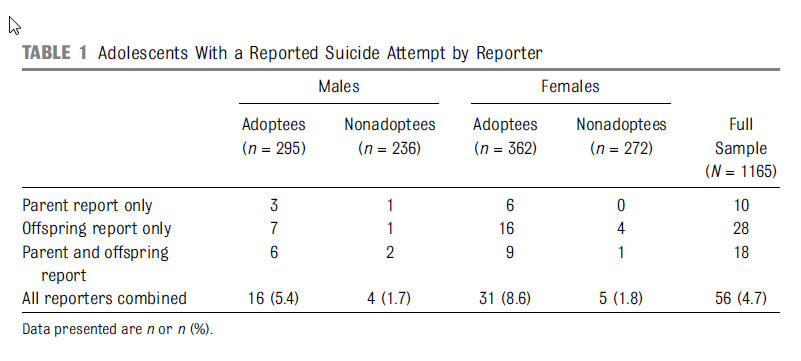
This finding represents the first demonstration of increased risk of suicide attempt in US adoptees placed in nonrelative families. These findings are consistent with those reported by Hjern who observed significant age- and gender-adjusted odds for suicide attempt in Swedish intercountry adoptees relative to comparably aged young persons (OR = 2.7).
Furthermore, we confirmed that factors known to be associated with suicidal behavior, including psychiatric disorder symptoms, personality traits, family environment, and academic disengagement, were elevated, individually and in the aggregate, in study participants who reported suicide attempts.
Suicide attempters and nonattempters differed by almost 2 SDs on a regression-weighted aggregate risk measure. We also demonstrated a significant, albeit smaller, mean difference between adopted and nonadopted participants on aggregate risk and many individual measures. Finally, we examined whether aggregate risk mediates the relationship between adoption and suicide attempt.
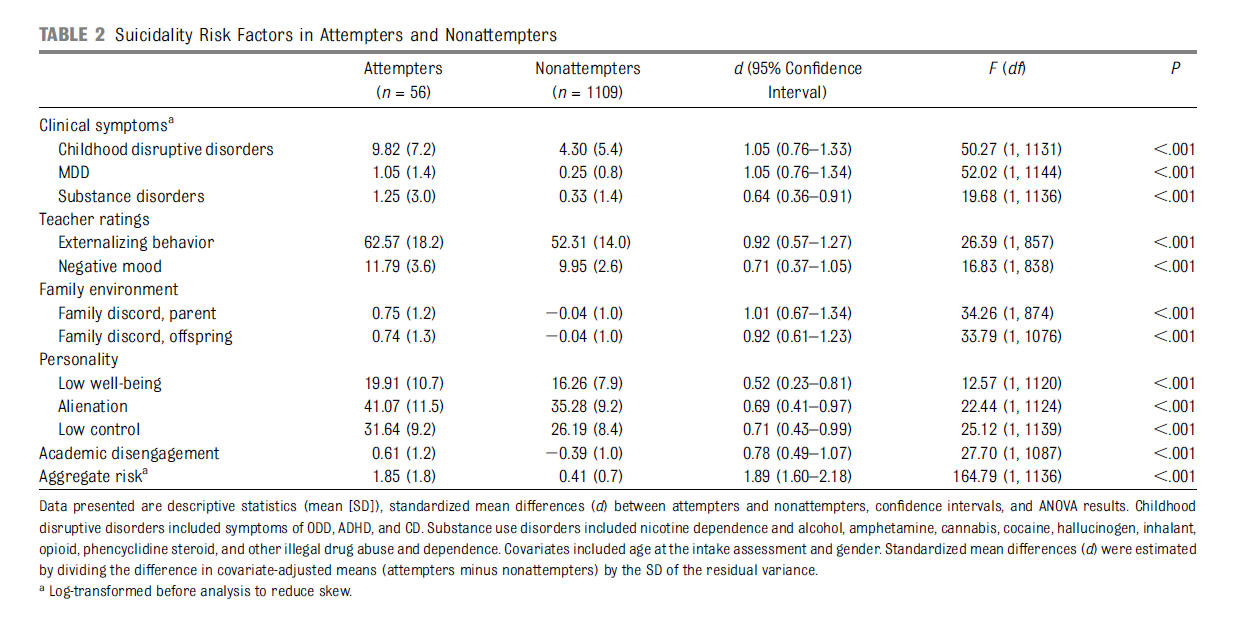
The odds of reporting a suicide attempt in adoptees were reduced when conditioned on aggregate risk, although remained significantly elevated.
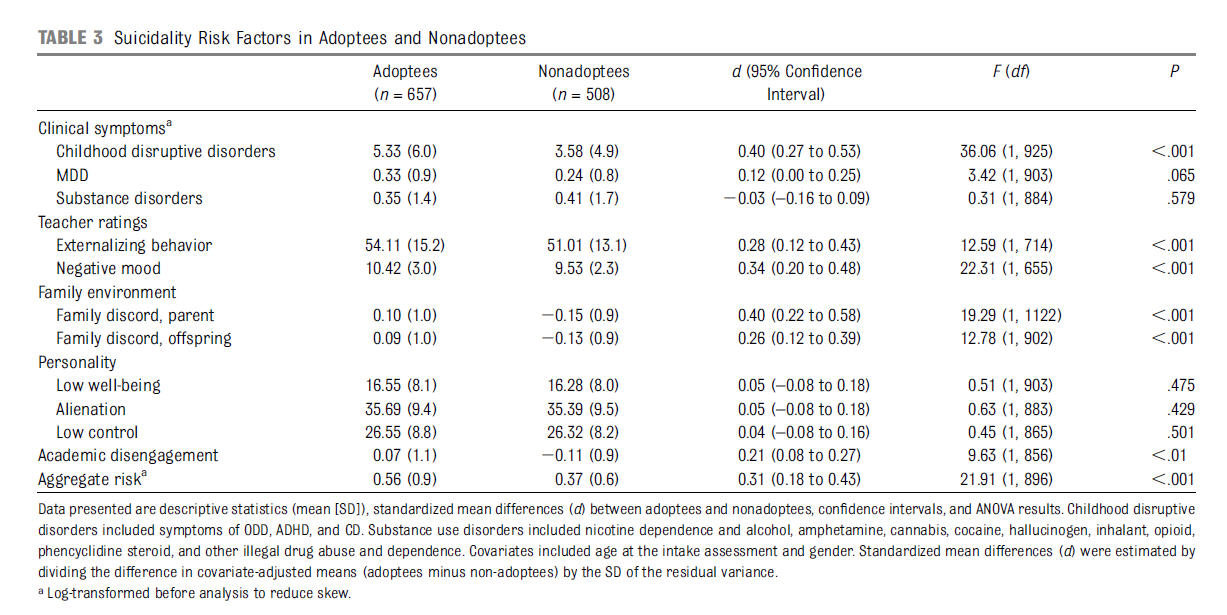
Why a Higher Risk of Suicide Attempts in Adopted People
The risk of suicide attempt associated with adoption may be due to various influences. von Borczyskowski confirmed that Swedish adoptees carry a higher burden of heritable risk for suicidality, that is, biological parents’ substance abuse, suicidal behavior, and psychiatric illness explained one-third of increased risk of suicide attempt in domestic adoptees.
Factors unique to relinquishment by a biological parent (eg, early trauma, institutional care, attachment issues) may also elevate risk for suicidal behavior later in life. Hjern et al demonstrated increased risk for suicide death in individuals exposed to foster care or other child welfare interventions. Because all SIBS participants were adopted before 2 years of age, however, the preplacement period was relatively limited.
Moreover, length of the preplacement interval did not predict reported suicide attempt. Young adult adoptees may demonstrate impairment in social adjustment that is associated with weak attachment to adoptive families and, for internationally adopted children, loss of cultural identity and ethnic discrimination. Compared with nonadopted individuals, intercountry adoptees in Sweden and the Netherlands were less likely to have long-term intimate relationships, live with a partner, or be married. Furthermore, in Sweden, odds for suicide attempt were reduced for domestic adoptees, although they were still elevated relative to nonadoptees.
In our sample, however, there was no significant difference in odds for suicide attempt between domestic and intercountry adoptees, and nonwhite ethnicity did not predict suicide attempt.
Our results provide additional information on the adjustment of adopted individuals. Consistent with results reported using the full intake sample, adoptees had a greater number of childhood disruptive disorder symptoms relative to nonadoptees and elevated scores on teacher reports of externalizing behavior and negative mood.
In these analyses, adoptees were further distinguished from nonadoptees by moderately large differences on family discord and smaller differences on academic disengagement.
Adoptees did not evidence significantly more substance use disorders or MDD symptoms and showed no differences on personality scales.
Our research is not without limitations. The sample of nonadopted adolescents does not represent the ethnic diversity present in US adolescents. Adoptees were ascertained from adoption agencies only. Our sample does not include placements arranged directly between birth and adoptive parents or permanent placements of foster children by local government agencies. Because we have no information on biological relatives of adoptees, we were unable to assess the role of genetic factors in mediating increased risk of suicide attempt. Similarly, we had no information on preplacement experiences, including institutional rearing or early trauma.
Finally, we had little systematic information on the nature of the reported suicide attempts.
CONCLUSIONS
Our results indicate the odds of a reported suicide attempt between intake and F1 are ∼4 times greater in adoptees compared with nonadoptees.
Aggregate risk partially mediates the relationship between adoption status and suicide attempt. After adjusting for aggregate risk, the odds of reporting a suicide attempt were reduced but still significant and substantial. The implications of these findings are twofold. Clinicians should be aware of increased potential for suicide attempt in adopted adolescents who manifest other risks for suicidal behavior. For researchers, continued inquiry into those factors mediating this increased risk may inform the larger investigation of suicidality in adolescents.
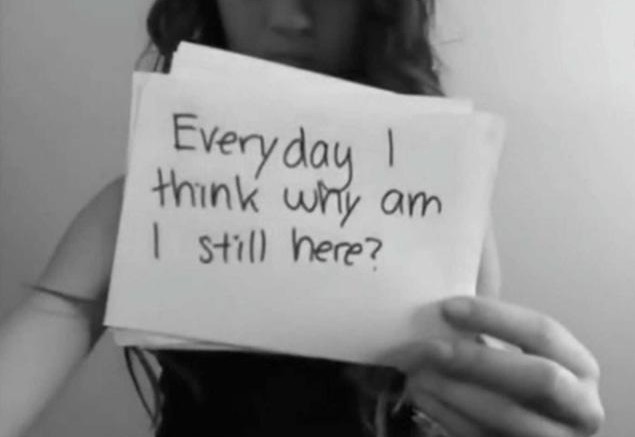


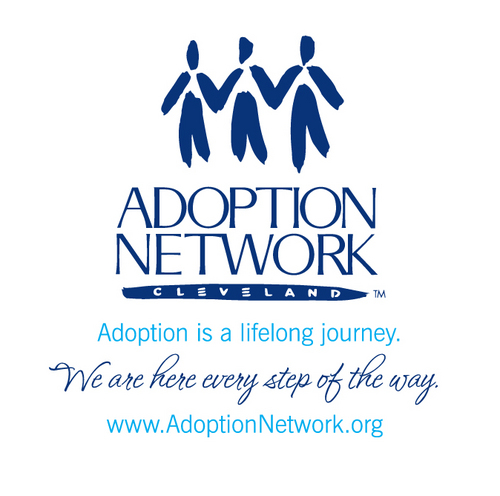
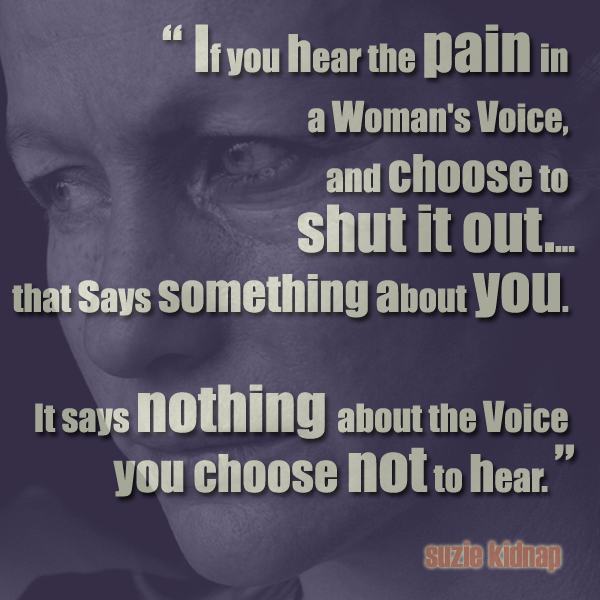
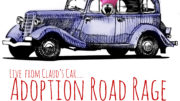
This makes me sick to my stomach. I wish I would have known this 18 years ago. When I read about adoptees having a higher suicide rate, I attributed it to children being adopted through foster care. I know they experience a lot of trauma before before, during and after removal from their families. It breaks my heart to think that I may have caused harm to my lost daughter.
Yup! It’s insane to think that adoption agencies still do not present these facts to mothers considering adoption. So much for an informed decision!
Poor Melanie. Didn’t you sense that being left by her mother would harm your daughter? Were you told loving choice lies, told to consider yourself as strong, while you failed as a mother. My heart breaks for you.
Theodore, While you have a right to be angry at the lies and mistrusts told by the adoption industry, your false sense of sympathy and sarcasm is not appreciated.
Stop being a dick to people you don’t know. YES, we were told lies. YES we were told that we were BETTER mothers for giving our children away. And YES, we did fail, we KNOW we did, but we were also failed. If you know that we were told lies, then take a second to get out of your own place of pain and try to understand that for a hot minute. The guilt of being tricked and fooled and now knowing that yes, we DID take a chance to harm our own child sucks enough. Rubbing slat in the wound doesn’t help.
These risks are not worth it, not when so many first mothers would have made great parents. The unnecessary separations of children from their family need to stop.
wow.poor Teddy .so pissed off 🙂 Interesting to note the array of ” disorders” that abound in the selected adopted people. Childhood disruptive orders…..otherwise known as acting out….or traumatised….and depressed…and low self esteem….all of these seem to proliferate amongst the adopted group. My personal opinion is that these ‘ disorders ” are in fact a very normal reaction to adoption